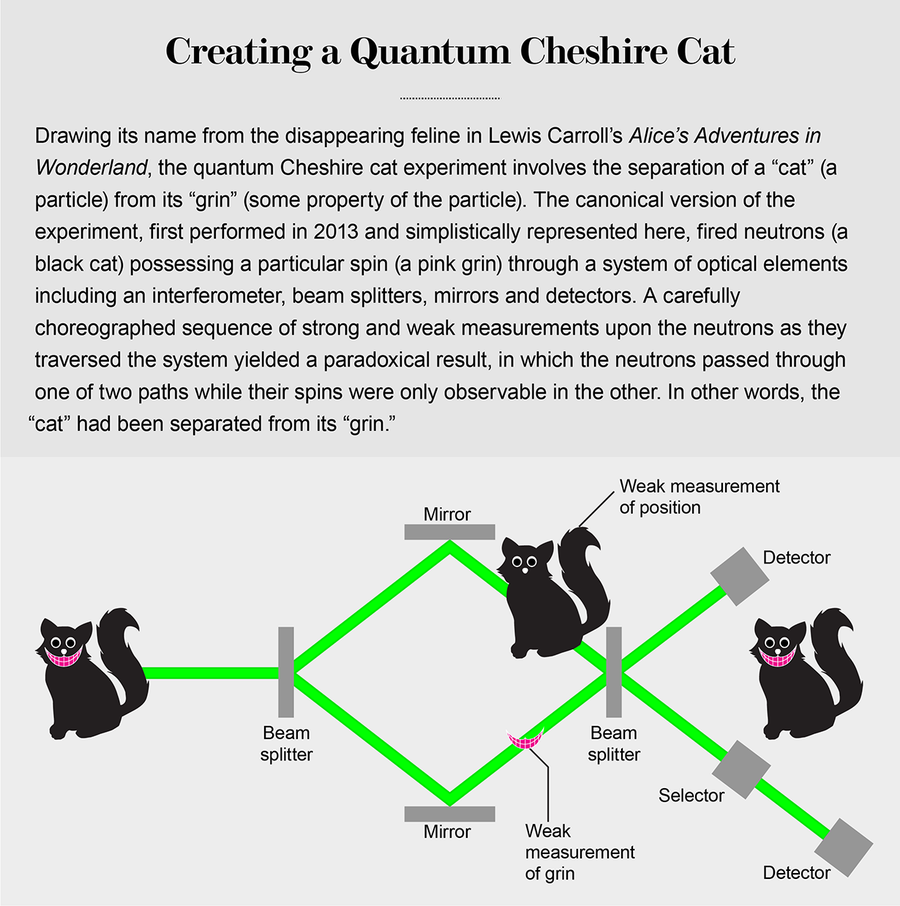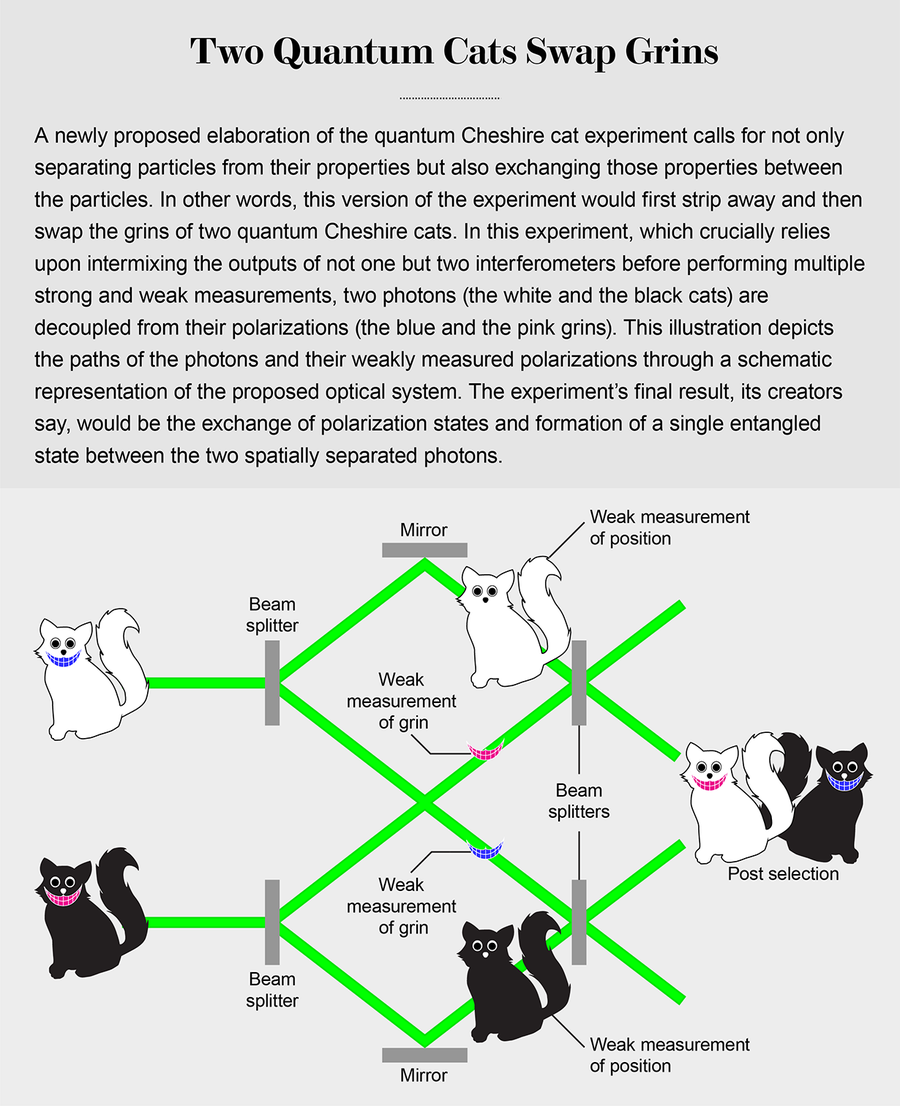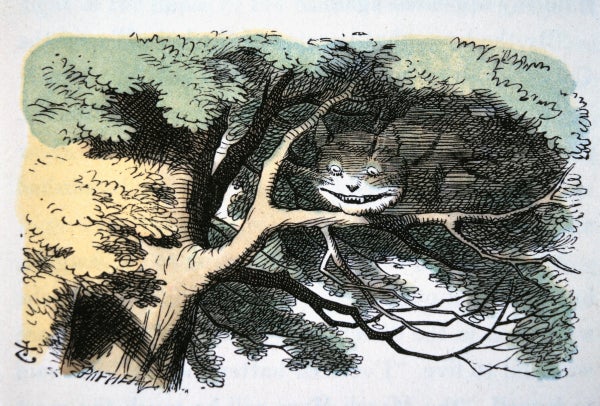One of the most mind-bending revelations of quantum physics over the past century has been that properties of particles are possibly not real until they are measured. Now a thought experiment suggests that conclusion may be too tame: it seems that particles' properties—their spin, for instance—may not even belong to them. This possibility is akin to saying that your personality does not belong to you.
The study claims to demonstrate this paradoxical disconnect between particles and their properties via a version of the so-called quantum Cheshire cat experiment. First performed in 2013, the experiment draws its name from the disappearing feline in Lewis Carroll's Alice's Adventures in Wonderland and involves the ostensible separation of a cat (actually, a particle) from its grin (some property of the particle).
The new version of the experiment starts with two grinning Cheshire cats and ends with the grin of one cat gracing the other cat's face, and vice versa. In quantum terminology, it shows how two particles could end up exchanging their properties, or physical attributes.
On supporting science journalism
If you're enjoying this article, consider supporting our award-winning journalism by subscribing. By purchasing a subscription you are helping to ensure the future of impactful stories about the discoveries and ideas shaping our world today.
“Niels Bohr's view [was] that until you do a measurement on a quantum system, you cannot say that the physical attribute actually exists. That questions the reality of physical attributes,” says Arun Kumar Pati of the Harish-Chandra Research Institute (HRI) in India, who co-authored the work. “Our thought experiment takes that view a step ahead. Not only are the attributes not real, but they could not be yours. It questions the reality at a much deeper level.”
The Weak vs. The Strong
To arrive at their conclusion, Pati and his HRI colleague Debmalya Das resorted to a technique known as weak measurement.
In standard quantum mechanics, examining the state of a quantum system—such as a particle or an atom—involves a so-called strong measurement, which can be something as simple as a detector registering the arrival of a photon. A particle is first prepared in some initial state, a process called preselection. Then the quantum state of the particle evolves over time, under the influence of external forces, and it can end up in a superposition of many states. The strong measurement randomly “collapses” the superposition into one of those many possible states—a process that is unavoidably destructive. For example, if you were measuring the position of a photon, a strong measurement would locate the photon but also destroy the superposition.
Weak measurements, in contrast, are not so heavy-handed. They represent an idea that goes back to 1988, to a theory devised by Yakir Aharonov, David Z. Albert and Lev Vaidman, all then at the University of South Carolina and Tel Aviv University. The trio asked, What if the measuring device interacted extremely weakly with the particle? While such a measurement would not destroy the quantum state (and thus the state would continue evolving), it would result in a value for the state with a very large uncertainty. If you performed the measurements over and over again, with an ensemble of identically prepared, or preselected, particles, then you would get a distribution of weak measurement values.
On its own, this distribution is not informative. But add one more stage to the process, and things get very interesting. After each weak measurement, you let the particle evolve and then perform a strong, destructive measurement on it. Repeat this action for every identically preselected, weakly measured particle. Each strong measurement will give a different value because of the random collapse of the superposition. Now select only those particles whose final positions have a certain value—doing so is called postselection. Then discard information about all of the particles that do not end up in this postselected stage. What Aharonov and his colleagues argued is that you can now take the weakly measured values for the subset of postselected particles and turn them into a “weak value” that tells you something about a property of the particles, such as their spin in a given direction.
An intriguing outcome of this approach to quantum systems has to do with the nature of time. According to the mathematics developed by Aharonov and his colleagues, weak values are influenced by both the initial preselected quantum state (the past) and the final postselected quantum state (the future). Time, in this way of thinking, flows both ways: the future influences the present.
Whose Property is it, Anyway?
In a first-of-its-kind experiment published in 2014, Tobias Denkmayr of the Vienna University of Technology, Jeff Tollaksen of Chapman University and their colleagues used weak measurements to separate the quantum Cheshire cat from its grin.
In their experiment, preselected neutrons with a particular spin were sent, one by one, into a beam splitter, which is a device that splits a beam of particles into two. Each incoming neutron ended up in a superposition of two states: taking paths A and B. These two paths were recombined in a so-called interferometer, which caused the quantum states to interfere. The neutrons then headed toward output detectors. In one of the output paths of the interferometer, the experiment involved a strong measurement of a particular spin state of the neutrons. Neutrons that satisfied this criterion were considered to be postselected. The experimenters discarded all of the other neutrons for their analysis.
For the postselected particles, the team also performed two sets of weak measurements: one for the position of the particles and the other for their spin. These dual measurements suggested that the particles were going through path B, whereas the weak value of their spin could be measured only in path A. The cat had been separated from its grin.

Credit: Melissa Thomas Baum, Buckyball Design; Source: “Observation of a Quantum Cheshire Cat in a Matter-Wave Interferometer Experiment,” by Tobias Denkmayr, et al, in Nature Communications, Vol. 5, No. 4492; July 29, 2014
“From the old perspective of preparing a particle and then doing a strong measurement, it is impossible to separate a particle from its properties,” says Tollaksen, who wrote about the Cheshire cat paradox in his 2001 Ph.D. thesis.
Now Pati and Das have extended the Cheshire cat experiment to their thought experiment, which not only separates a particle from its properties but also causes one particle to take on a property previously associated with another, and vice versa.
The thought experiment involves putting two interferometers side by side, such that each particle first encounters a beam splitter. After going through the beam splitter, the particle enters into a superposition of two states: taking the left and right paths.
Then comes a twist: The alignment of the setup is such that interferometer 1's right path, which would normally be recombined with its corresponding left path, is instead recombined with interferometer 2's right path. And the interferometers' left paths are recombined as well. When recombined, the various quantum states interfere with one another. Then the two outputs from each interferometer encounter a series of beam splitters and detectors. These beam splitters are designed to make photons with one type of polarization go one way and the rest go the other way. (Polarization describes the orientation of a photon's vibrating electric and magnetic fields.) The postselection involves choosing only those photons that cause a particular set of six detectors to click simultaneously. All other photons are discarded.
According to Pati and Das, if one were to calculate weak values for the position and polarization of each pair of photons in the postselected ensemble, then the weak values would show that photon 1 went through the left arm of interferometer 1, whereas its polarization would appear in the left arm of interferometer 2. Similarly, photon 2 would appear in the right arm of interferometer 2, whereas its polarization would show up in the right arm of interferometer 1. At least, that is how the researchers interpret the weak values.

Credit: Melissa Thomas Baum, Buckyball Design; Source: “Can Two Quantum Cheshire Cats Exchange Grins?” by Debmalya Das, et al., in arXiv.org at https://arxiv.org/ABS/1904.0770; April 14, 2019
This interpretation of the thought experiment suggests that after the particles and their properties are decoupled, and their paths are recombined and finally subjected to strong measurements, photon 1 ends up with the polarization of photon 2, and vice versa. The cats and their grins are first separated, and then the cats exchange grins. Also, the photons, despite being separated from their initial properties, all end up in one massive entangled state—meaning that they can be described only by a single global quantum state.
“It doesn't surprise me,” says Tollaksen, who is used to the seeming paradoxes thrown up by weak measurements. But “it's very good work.”
A Disagreement Over Details
Experimentalist Aephraim Steinberg of the University of Toronto is also not surprised but for different reasons. He points out that an interaction between particles results in those particles getting entangled (as happens in Pati and Das's thought experiment), and this entanglement can lead to the particles swapping properties. Such swapping is the basis of a so-called SWAP gate, a well-studied operation used in quantum computing, Steinberg says. “It would indeed be interesting if they could swap their polarizations without ever interacting,” he adds.
But Steinberg is more surprised, even concerned, by the new experiment's design. “It relies on two photons traversing a set of interferometers and then causing six different detectors to fire simultaneously. This is, of course, impossible,” he says. “The authors seem to be imagining one detector sensitive to where a photon is while another detector (at another location) could simultaneously measure the photon's polarization. In this sense, they seem to be trying to ‘build in' the separation of the photon's different properties from the start rather than devising an experiment to reveal it.”
Tollaksen also says that having six detectors firing simultaneously with only two photons is simply not possible. But he thinks Pati and Das's conceptual idea is sound. “As far as I can tell, it seems to me that even the requirement of all six [detectors] could be boiled back down to two with the right optics and still produce the right postselection,” he says. “If so, the fundamental swapping idea they are playing with might be salvageable.”
But Pati says that his and Das's experiment should work as designed—and with existing technology, too. “The detector clicks are for various degrees of freedom or attributes of the two photons,” he says, thus allowing for six simultaneous detections.
There is also a bigger issue of whether the weak values obtained via weak measurements are telling us something about what is real. “In general, I think too much is made of the quantum Cheshire cat being a paradox,” says theorist Michael Hall of the Australian National University. “Weak values are not the outcomes of individual measurements in general. They are only average values of many repeated measurements.” Hall argues that such average values cannot be accorded the same status as the outcome of individual strong measurements.
Nevertheless, weak measurements are already being used for seemingly impossible applications. For example, if one selects the initial state and the postselected state of particles such that there is very little overlap between the two, then the percentage of particles that have to be thrown away because they are not postselected becomes very large. But for the very few that remain, the weak values can be extremely useful. John C. Howell of the University of Rochester and his colleagues have already used such weak values to measure displacements of about 14 femtometers, which is roughly the size of a uranium nucleus.
Concerns about Pati and Das's thought experiment notwithstanding, the debate over the meaning of weak values is also one over the correct theory for describing the quantum world, particularly the role of time. “You need to start thinking about the relevance of the future on the present. The property [of a particle] at any given moment of time is influenced by the future,” Tollaksen says. “When you shift your thinking to that, then all of these things, like the Cheshire cat, are not at all surprising.”

